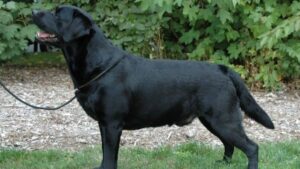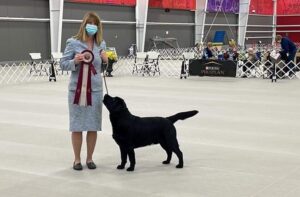
The Labrador Retriever
Labrador Retrievers: America’s top breed for 20 years, prized for their versatility, temperament, and historic origins.
Home » Meet The Breeds » Labrador Retriever



The Labrador Retriever has consistently been one of the most treasured dog breeds in the United States and internationally. Originating from the rugged coasts of Newfoundland, this breed was initially developed to aid fishermen and hunters by retrieving gear and game from water and land. Esteemed for its affable nature and multifaceted abilities, the Labrador excels in a variety of roles: from faithful family companion and skilled service animal to athletic competitor and diligent working dog.
Sporting
21.5 – 24.5 inches
55 – 80 pounds
11 – 13 years
| Country of Origin | Canada, England |
|---|---|
| Bred For | Hunting, Fishing |
| Known For | Gentle Nature, Friendliness, Muscular Figure |
| Popularity | High |
| Temperament | Friendly, Outgoing, Active |
| Activities | Hunting, Running, Conformation Shows, Dog Sports, Assistance Dog, Rescue Dog |
The Labrador Retriever’s journey from a working dog in the cold North Atlantic to one of the most beloved breeds around the globe is a testament to its adaptability, intelligence, and amiable nature. Initially known as the St. John’s Dog, the breed found its early roles in Newfoundland, assisting fishermen by retrieving fish and helping to haul in nets. This early version of the breed was essential for its practical working abilities, not just companionship.
As the breed caught the attention of English noblemen in the 19th century, its journey across the Atlantic marked the beginning of the Labrador as we know it today. These enthusiasts saw in the St. John’s Dog an ideal sporting and hunting companion, thanks to its keen retrieving instincts, love for water, and trainable nature. Through selective breeding, they refined the dog’s physical characteristics and temperament, giving birth to the modern Labrador Retriever.
The recognition of the breed by prominent kennel clubs solidified its status and standardized its traits, focusing on qualities like a strong physique, keen intelligence, and good temperament. It wasn’t long before Labradors transcended their working-class roots to become favored pets, show dogs, and versatile working dogs.
Beyond their traditional roles in hunting and fieldwork, Labradors have distinguished themselves in various service roles. Their intelligence and gentle demeanor make them exemplary guide dogs, therapy animals, and participants in search-and-rescue missions. Moreover, their acute olfactory skills have been invaluable in detection tasks, assisting in law enforcement and medical fields.
The Labrador Retriever’s appeal as a family pet is equally significant. Their friendly and patient nature makes them excellent companions for children and adults alike, fitting seamlessly into various family settings and lifestyles. The breed’s popularity in the United States and worldwide is a reflection of its adaptability, loyalty, and the joy it brings to people’s lives.
Through generations, the Labrador Retriever has evolved from a practical working dog to a beloved family member, without losing its heritage of versatility and service. Its history is not just a record of its past but a living legacy that continues to unfold in homes and fields, in service and companionship, across the world. The Labrador’s story is one of enduring partnership with humanity, a narrative rich with loyalty, service, and love.
Male Labrador Retrievers typically stand about 22.5 to 24.5 inches tall at the withers, with females slightly smaller, ranging from 21.5 to 23.5 inches.
Weight should be in proportion to the height, with males weighing between 65 to 80 pounds and females between 55 to 70 pounds.
The Labrador Retriever is almost square in profile, with a strong, muscular build that reflects its origins as a capable, enduring retriever of game and fowl. Their well-developed chest reaches down to the elbows, and their back is level from the withers to the croup. Substance is evidenced in the Labrador’s solid, well-knit frame, providing the strength and power needed for its retrieving tasks. Yet, despite their robust build, Labradors should move with effortless efficiency, displaying good reach in the front and strong drive from behind, without any sign of clumsiness or heaviness.
Texture: The Labrador Retriever’s coat is one of its defining features, being short, dense, and straight with a distinctive water-resistant quality. This double coat consists of a soft undercoat that provides insulation and a tougher topcoat that repels water, enabling the dog to perform efficiently in various weather conditions. The coat’s texture is neither wooly nor silky but firm and likely to the touch, ensuring protection against brambles and water alike.
| Standard Color | |
|---|---|
| Black | ee |
| Chocolate | ee |
| Yellow | ee |
| Standard Marking | |
|---|---|
| White Markings | ee |

The tail of a Labrador Retriever is thick at the base, gradually tapering towards the tip, providing a powerful aid in swimming, much like an otter’s. It is covered with the same short, dense coat as the rest of the body, which further emphasizes its otter-like appearance. The tail is of medium length, extending no longer than to the hock, and is devoid of feathering, maintaining its thickness and shape throughout. The tail is never docked; it is left in its natural state.
When considering bringing a Labrador Retriever into your life, it’s essential to understand the breed’s specific needs and characteristics to ensure a happy and healthy life for your canine companion. Labradors are renowned for their friendly and outgoing nature, making them excellent family pets. However, they are also energetic and require ample exercise and mental stimulation to keep them content and well-behaved. Prospective owners should be prepared to provide plenty of playtime, walks, and interaction.
The health of a Labrador Retriever is a vital aspect that requires attention and care from any responsible handler or caretaker. Generally, Labradors are known for their robust health, but like any breed and mixed breed, they are prone to certain health conditions. The average lifespan of a Labrador Retriever typically ranges between 11 and 13 years.
While the Labrador Retriever is generally robust and hearty, certain genetic conditions are of concern and potential owners should be aware of these health risks:
Understanding these risks and discussing them with a veterinarian can help Labrador Retriever owners ensure their pets receive the best possible care, emphasizing the importance of genetic testing and regular health screenings in the breed’s overall wellness strategy.
The Labrador Retriever is celebrated for its amiable and outgoing personality, traits that make it a top choice not just for families but for various service roles as well. When considering a Labrador Retriever’s personality, it is essential to delve into several aspects to truly appreciate this breed’s adaptability and social nature.
Labradors are renowned for their friendly demeanor, making them excellent companions for both children and adults. They typically show a great deal of affection for their family members and are known to be particularly patient and gentle with children. This breed’s sociability extends to other dogs and even strangers, as Labradors are usually eager to greet new friends with a wagging tail and an enthusiastic demeanor.
While Labradors are well-suited to novice dog owners due to their generally agreeable and teachable nature, their high energy levels and need for engagement mean they thrive best with active individuals or families who can provide them with ample exercise and interaction. Despite their friendly disposition, Labradors benefit from early socialization and training to harness their energy positively and reinforce good manners.
Their intelligence and eagerness to please make Labradors highly trainable, yet their sensitivity requires a gentle approach. Harsh methods can dampen their spirit, whereas positive reinforcement fosters a love of learning and cooperation. Labs are not well-suited to being left alone for long periods; they are social animals who prefer company and can become bored or destructive if isolated or under-stimulated.
Labradors generally get along well with other pets and are known for their non-aggressive demeanor, though they may enthusiastically engage in play. Their friendly nature typically extends to strangers, making them poor guard dogs but excellent ambassadors of goodwill.
Feeding a Labrador Retriever appropriately is crucial for its health, longevity, and overall well-being. Labradors are known for their hearty appetites and can be prone to obesity if their diet and food intake are not managed carefully. Understanding the nutritional needs of a Labrador Retriever will help ensure that your dog maintains an optimal weight and receives the necessary nutrients for a healthy life.
When feeding a Labrador puppy, it is essential to provide a diet formulated for large-breed puppies. This diet helps support their rapid growth and development while helping to prevent bone and joint problems later in life. Typically, Labrador puppies should be fed three to four small meals a day to support their high energy levels and rapid growth.
As Labradors transition into adulthood, their food intake should be adjusted to their activity level and weight to prevent obesity. Adult Labradors generally do well with two meals per day. It’s crucial to choose a high-quality dog food that provides balanced nutrition suited to their age, size, and activity level. Regularly monitoring your Labrador’s weight and body condition can help you make necessary adjustments to their diet.
Portion control is critical for Labradors due to their propensity to overeat. Following the recommended feeding guidelines on the dog food label and adjusting based on your dog’s specific needs can help maintain a healthy weight. Treats should be given sparingly and accounted for in the dog’s total daily calorie intake.
Exercise also plays a vital role in managing a Labrador’s weight. Regular physical activity not only helps burn calories but also stimulates the mind and provides an outlet for their energy.
Training a Labrador Retriever is an enjoyable and rewarding experience due to the breed’s intelligence and eagerness to please. These traits make them highly trainable and well-suited for a variety of roles, from family pet to service dog. However, as with any breed, a tailored approach to training is essential to harness their potential fully.
Labradors are known for their food motivation, which can be a double-edged sword. While it makes them responsive to treats as rewards, care must be taken to prevent overfeeding. Their intelligence means they pick up on commands quickly, but it also implies they can easily learn bad habits if not guided correctly. Consistency is key in Labrador training, ensuring they understand what is expected of them.
Despite their amiable nature, Labradors have a strong retriever instinct and can be prone to chasing wildlife or picking up forbidden objects. Training should, therefore, include commands to drop or leave items, as well as a solid recall to manage their impulses effectively. Their intelligence and energy also mean they require mental stimulation to prevent boredom, which can be provided through training exercises, puzzle toys, and ongoing learning opportunities.
The tendency to bark varies among individuals, but Labradors are generally not excessive barkers. They may, however, vocalize when excited or seeking attention. Training can help manage their vocalizations, ensuring they understand when it is appropriate to be quiet.
A Labrador’s friendly nature should not be mistaken for a lack of willfulness. They can be stubborn, particularly if they sense they can gain control over a situation or if they are not motivated. As such, training should be firm yet respectful, using positive reinforcement to build a strong bond and mutual respect.
Wanderlust is not typically a problem for Labradors compared to some other breeds, but they should still be taught to respond to commands even when distractions are present. This is particularly important given their sociable nature and tendency to greet new people or animals with enthusiasm.
Understanding the exercise needs of a Labrador Retriever is crucial for anyone considering this energetic and lively breed. Labradors are renowned for their high energy levels and stamina, traits that were essential in their original roles as fishermen’s helpers and hunting companions. As such, they require regular, vigorous exercise to maintain their physical health and mental well-being.
| Energy Level | High |
|---|---|
| Exercise Requirements | 80 Minutes/Day (Minimum), Daily Walks, Daily Exercise |
A Labrador’s need for exercise extends beyond simple physical activity; it also plays a key role in their mental stimulation and overall happiness. Regular play sessions, walks, and the opportunity to run and explore in a safe environment can help prevent the development of undesirable behaviors often rooted in boredom or excess energy.
The intensity of exercise for a Labrador should be adjusted according to the dog’s age, health, and fitness level. Puppies and younger dogs may have seemingly boundless energy and require more frequent bursts of activity, while older Labradors might prefer longer, more leisurely walks. Regardless of age, all Labradors benefit from a routine that includes both physical and mental challenges.
Playfulness is a hallmark of the Labrador personality, and engaging in interactive games such as fetch, tug-of-war, or hide-and-seek can provide both physical exercise and mental stimulation. Training sessions, agility courses, or even learning new tricks can also offer valuable mental workouts, reinforcing obedience while engaging their keen minds.
Despite their love for active play, Labradors also need to learn to relax and settle down. Teaching a Labrador to calm down after playtime is as important as the exercise itself, ensuring they can be well-behaved and content indoors after expending their energy outside.
Grooming a Labrador Retriever is a straightforward yet essential aspect of their care, helping to maintain their coat’s health and manage shedding. Labradors are known for their double coat, comprising a soft, weather-resistant undercoat and a sleek, protective outer coat. This dual-layer coat system serves to insulate the dog from various weather conditions and requires regular maintenance to keep it in good condition.
| Coat Type | Dense, Short, Straight |
|---|---|
| Grooming Requirements | Weekly Brushing, Occasional Bathing, Routine Ear Cleaning, Periodic Nail Trimming, Regular Tooth Brushing |
While Labradors are not the most high-maintenance breed in terms of grooming, they do shed throughout the year, with increased shedding typically occurring twice annually during the change of seasons. Regular brushing, ideally a few times a week, can significantly reduce the amount of hair shed around the house and help distribute the dog’s natural skin oils throughout their coat, promoting a healthy sheen and reducing the need for frequent baths.
Bathing a Labrador should be done as needed—too frequent bathing can strip the coat of its natural oils, leading to dry skin and irritation. When baths are necessary, using a dog-specific shampoo is crucial to maintaining skin and coat health.
In addition to coat care, regular grooming routines should include ear checks and cleanings to prevent infections, particularly given the Labrador’s propensity for ear issues due to their floppy ear structure. Nail trimming is also essential to prevent discomfort and potential problems with walking or running. Dental care should not be overlooked; regular teeth brushing can prevent dental diseases, which are common in all dog breeds.
Living with a Labrador Retriever is a rewarding experience that brings joy, companionship, and a lot of activity into a household. Given their adaptable and friendly nature, Labradors fit well into various living situations, but there are several aspects to consider ensuring they thrive in their environment.
Firstly, Labradors are known for their high energy levels and need for regular exercise. They are not suited to a sedentary lifestyle and require ample space to move around and play. While they can adapt to apartment living, it is essential that they are given plenty of daily exercise to prevent boredom and the development of destructive behaviors. A home with a securely fenced yard is ideal, providing them with space to explore and play safely.
In terms of weather tolerance, Labradors are quite versatile. Their double coat provides insulation against both cold and hot weather, but it is crucial to provide protection from extreme conditions. In colder climates, they should not be left outside without shelter, and during hot weather, they need access to shade and fresh water to prevent overheating.
Labradors are social creatures that thrive on human interaction and do not like being left alone for long periods. They are happiest when they are part of family activities and can become anxious or exhibit unwanted behaviors if isolated or neglected. Therefore, they are best suited to homes where they will receive plenty of attention and companionship.
When it comes to training and socialization, Labradors are eager learners and respond well to positive reinforcement techniques. Early training and socialization are vital for teaching them good manners and how to behave in various situations, which is particularly important given their size and strength.
Bringing a Labrador Retriever puppy into your home is an exciting and significant commitment. These adorable, energetic bundles of joy grow into large, active dogs, so early preparation and understanding of their needs are crucial for a harmonious integration into your family.
Caring for a Labrador puppy requires attention to their physical, emotional, and developmental needs. Initially, creating a safe and welcoming environment is essential. Puppy-proofing your home by removing hazardous objects and substances they can chew or swallow is crucial to prevent accidents and ensure their safety.
Nutrition plays a vital role in your puppy’s health and development. Feeding a high-quality diet formulated for large-breed puppies will support their rapid growth and energy levels. It’s essential to adhere to a feeding schedule, dividing their daily food intake into smaller, more manageable meals to promote healthy digestion and prevent overeating.
Socialization and training should begin early, introducing your puppy to a variety of people, animals, and environments in a positive and controlled manner. This exposure helps develop a well-adjusted, confident adult dog. Basic obedience training, using positive reinforcement methods, establishes good behavior patterns and strengthens the bond between you and your puppy.
Routine veterinary care is crucial during this formative stage. Vaccinations, deworming, and regular check-ups will help protect your puppy from infectious diseases and identify any health concerns early on. Discussing a preventive healthcare plan with your veterinarian, including spay or neuter options, is also important.
Exercise and play are vital components of your Labrador puppy’s daily routine, aiding in their physical development and providing an outlet for their abundant energy. However, it’s important to monitor their activity levels to avoid overexertion, particularly during rapid growth phases.
Labrador Retrievers are highly versatile and excel in a variety of activities and dog sports, showcasing their intelligence, agility, and eagerness to please. Their well-rounded capabilities and enthusiastic nature make them standout competitors and beloved partners in numerous canine disciplines.
Engaging a Labrador Retriever in these sports and activities provides not only physical and mental stimulation for the dog but also a unique opportunity to strengthen the bond between dog and handler, celebrating the breed’s versatility and joyous nature.
The Labrador Retriever is recognized by the world’s leading registries and kennel organizations, which categorize the breed into a specific Group based on its unique characteristics. This breed is recognized worldwide under the following Group designations:
| Organization | Group Designation |
|---|---|
| AKC (American Kennel Club) | Sporting |
| UKC (United Kennel Club) | Gun Dog |
| CKC (Canadian Kennel Club) | Sporting Dogs |
| ANKC (Australian National Kennel Council) | Gundogs |
| RKC (The Royal Kennel Club) | Gundog |
| FCI (Fédération Cynologique Internationale) | Group 8: Retrievers, Flushing Dogs, Water Dogs; Section 1: Retrievers |
The ideal Labrador Retriever is described by a Breed Standard that is approved by each of the world’s leading registries and kennel organizations. The Breed Standards for this breed may be found in the following links:
| Organization | Breed Standard |
|---|---|
| American Kennel Club | AKC Labrador Retriever Breed Standard |
| United Kennel Club | UKC Labrador Retriever Breed Standard |
| Canadian Kennel Club | CKC Labrador Retriever Breed Standard |
| Australian National Kennel Council | ANKC Labrador Retriever Breed Standard |
| The Royal Kennel Club | RKC Labrador Retriever Breed Standard |
| Fédération Cynologique Internationale | FCI Labrador Retriever Breed Standard |
Labrador Retriever clubs play a crucial role in the support and promotion of the breed, offering resources, events, and community for Labrador enthusiasts and breeders. These clubs are dedicated to the health, welfare, and betterment of Labradors, providing a platform for education, competition, and breed advocacy.
In the United States, the Labrador Retriever Club, Inc. (LRC) stands as the AKC Parent Club representing the breed. Founded in October 1931, the LRC is committed to promoting the standard of the breed, supporting responsible breeding practices, and fostering a community of Labrador lovers who can share in the joy and responsibility of owning these dogs. The club organizes events, supports health research, and provides educational resources for both members and the general public.
In Canada, the Labrador Retriever Club of Canada (LRCC) serves a similar purpose, advocating for the breed’s health and welfare, supporting responsible breeding, and offering resources for education and competition. The LRCC is active in promoting the breed standard, organizing events, and providing a network for Labrador enthusiasts across the country.
In the United Kingdom, The Labrador Retriever Club is one of several organizations dedicated to the breed. Established in 1916, it is the oldest of such clubs in the UK and works diligently to ensure the Labrador’s health, promoting good breeding practices, and offering a supportive community for owners and breeders.
By joining a Labrador Retriever club, owners and breeders not only find resources and community but also have the opportunity to contribute to the breed’s legacy, promoting the health, well-being, and positive public perception of Labradors for generations to come.
Labrador Retriever rescue organizations across the world are dedicated to providing care and new homes for Labradors that find themselves without a family. These groups work tirelessly to ensure that each dog receives the love, medical care, and training it needs before being placed in a forever home.
In the United States, organizations like Lab Rescue LRCP, Labs4rescue, Inc., and Lu’s Labs are at the forefront of these efforts, operating across multiple states and touching the lives of countless Labradors and their adoptive families. They work through networks of volunteers, foster homes, and veterinarians to provide a support system for these animals, preparing them for life in their new homes.
Canada is home to Labrador Retriever Adoption Service Inc. The organization focuses on rescuing Labradors within specific provinces but often extends their help beyond those boundaries, addressing the needs of Labradors across the country.
Local shelters and broader animal rescue organizations are equally critical in the landscape of pet adoption and animal welfare. These entities provide sanctuary, medical care, and rehabilitation to a wide array of animals, not just Labradors or specific breeds, ensuring that countless pets find their way to loving homes each year.
Labrador Retrievers typically live between 11 and 13 years. Like all breeds, their lifespan can be influenced by various factors, including genetics, diet, exercise, and access to quality veterinary care. Responsible ownership and preventive health measures can help ensure they live full, happy lives.
Yes, Labrador Retrievers do shed. They have a dense double coat that sheds year-round, with increased shedding during spring and fall. Regular grooming, including brushing a few times a week, can help manage shedding and keep their coat healthy.
No, Labrador Retrievers are not considered hypoallergenic. They shed fur and dander, which can trigger allergies in sensitive individuals. People with dog allergies may experience symptoms around Labradors, though reactions can vary from person to person.
Labrador Retrievers typically stop growing by the time they reach 12 to 18 months of age. However, they may continue to fill out and gain muscle until they are about 2 years old. Proper nutrition and exercise are crucial during their growth phase to ensure healthy development.
Yes, Labrador Retrievers are known for their intelligence and trainability. They are ranked among the top breeds for intelligence, particularly regarding obedience and working intelligence. This makes them suitable for various roles, including service work, search and rescue, and as family pets.
Labrador Retrievers are generally not aggressive and are known for their friendly and outgoing nature. However, like any breed, individual temperament can vary, and behavior can be influenced by training, socialization, and the dog’s environment. Proper upbringing and socialization are key to fostering a well-adjusted and gentle temperament.
While Labrador Retrievers are loyal and protective of their families, they are not typically considered good guard dogs due to their friendly nature. They are more likely to greet strangers with a wagging tail than a fierce bark. However, their presence and barking can still provide a deterrent to unwanted visitors.
Labrador Retrievers can be good with cats, especially if they are raised together or properly introduced at a young age. Their friendly and sociable nature often makes them adaptable to living with other pets. However, individual personalities and experiences can vary, so supervision and proper introductions are important.

Labrador Retrievers: America’s top breed for 20 years, prized for their versatility, temperament, and historic origins.

Labradors, America’s top dog for 20 years, excel in versatility as family pets, hunting partners, and service dogs.

Explore the Labrador Retriever breed, from its role in hunting and rescue to its place as a family companion. Read more.

Judy Chambers is the breeder behind Ghoststone Labrador Retrivers. Read about the kennel’s beginnings, puppies, and much more!

Dawn Mieth is the breeder behind Mocha Labradors. Read about the kennel’s beginnings, the sires, the dams, the puppies, and much more!

Jacquelin DeAngelo: Where do I live? How many years in dogs? How many years as a breeder? For most of adult life, I’ve lived on Long Island,
The best way to ensure a long and happy relationship with a purebred dog is to purchase one from a responsible breeder. Not sure where to begin?
Contact the National Parent Club’s Breeder Referral Program, which is listed on the AKC Breeder Referral Contacts page.
